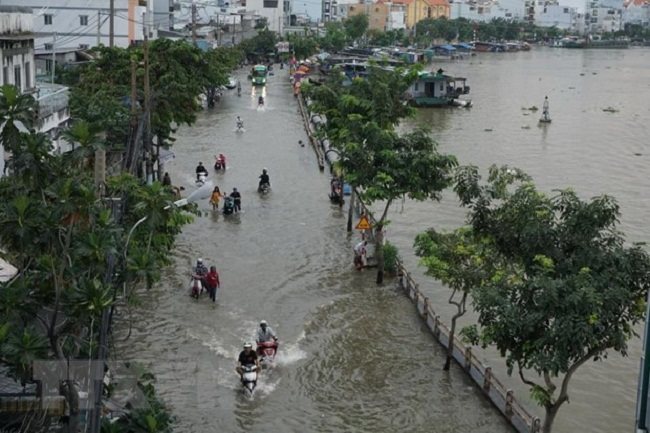 |
|
Tran Xuan Soan Street in District 7, HCMC was heavily flooded on September 29, 2019. HCMC, the economic center of Vietnam, is at high risk of being submerged, says Moody’s Investors Service – PHOTO: VNA
|
The United States-based ratings agency said in its January 16 report, called “Sea level rise poses long-term credit threat to a number of sovereigns,” that the rated sovereigns with the largest shares of population whose living areas would be submerged are Vietnam, Egypt and Suriname.
Also, the greatest inundation by proportion of land area would be in the Bahamas, followed by Vietnam and Qatar.
Measured by gross domestic product (GDP), Moody’s cited a report by the World Bank as indicating that that exposure is greatest in Vietnam (10.2% of GDP), Egypt (6.4%), Suriname (6.4%) and Benin (5.6%).
“Taking a broader view of exposure, by combining several indicators (GDP, population, land area, agricultural area, degree of urbanization, and wetlands), Vietnam, Egypt, Suriname and the Bahamas feature among the most exposed countries,” said Moody’s.
In a scenario where sea level rise reaches three meters, the population below sea level more than doubles to 3% of the total population, according to the World Bank study.
Suriname, Vietnam and Egypt remain the most vulnerable, with 31%, 26% and 15% of their populations exposed, respectively. Vietnam and Suriname are also the most exposed countries by economic output, followed by Benin and the Bahamas.
To extend its analysis, Moody’s looked at another study, Kopp et al (2017), which links projections of Antarctic ice sheet changes with a sea level rise projection framework.
The study found that proportions ranging between 10-41% of the populations of the Netherlands, Vietnam, Suriname, Macao and the United Arab Emirates live on land that will be submerged by 2100, based on a one-meter rise in sea levels.
It used projections that estimate sea level rise ranging between 0.8-1.5 meters under a high emissions scenario, and between 0.5-0.6 meters under a low emissions scenario.
“Differences in exposure estimates from the World Bank study stem in part from different geographic scope. But Vietnam and Suriname feature among the most exposed in both studies,” said Moody’s.
Another recent study by Climate Central, published in October 2019, uses the estimates of Kopp et al (2014), which are based on sea level rise ranging from 0.3-0.8 meters to 0.5-1.2 meters and combines these with a new method to measure coastal elevation and determine population exposure.
It found in both the mid-century and 2100 projections, the largest exposed populations in absolute terms are in Asia, in China, Bangladesh, India, Vietnam, Indonesia and Thailand.
Outside small island economies, the most exposed countries when considering locked-in sea level rise are Vietnam, Bahrain, the United Arab Emirates and Bangladesh, said Moody’s, adding that major cities that would be submerged include Alexandria, Bangkok, Dhaka, Dubai, HCMC, Miami, Mumbai and Shanghai.
The agency noted that for Vietnam, Egypt and Suriname, which have large populations exposed to sea level rise, the share of agriculture in employment and GDP is sizeable. Lower agricultural yields resulting from crop damage due to sea level rise would persistently curb incomes.
The Mekong River and its tributaries form Vietnam’s “Rice Bowl” – four-fifths of the population living in the area is engaged in rice production – which faces inundation.
The agency warned that coastal cities are often densely populated and serve as ports and nodes for regional and global supply chains and trade. Several ports in Asia are particularly exposed to sea level rise.
“For Vietnam, Singapore and Hong Kong, unmitigated repeated or long-lasting disruption to the main ports' activity would hurt trade and GDP growth,” said the agency.
In Vietnam, a number of projects have focused on adapting to flood stresses, including upgrading a storm sewer system in HCMC. Authorities are also looking to construct a large sea wall or tidal barrier, and ring dykes to protect the city.
In the country’s rural areas, studies found that households are veered toward soft coping mechanisms, including diversifying sources of income, and shifting to less vulnerable crops.
Sea level rise and related shocks pose material credit risk to Vietnam and several other economies.
“The pace of increase in the frequency and severity of natural disasters related to sea level rise and the effectiveness of adaptation measures will determine the extent of the credit constraints that these sovereigns face,” said Moody’s.
The agency added a relatively gradual increase in the frequency and severity of sea level-related disasters would give governments some time to adapt.
However, if the manifestations of sea level rise intensify abruptly, without effective adaptation, these sovereigns may face some downward rating pressure. SGT
 Vietnam (Ba3, negative) is one of the most exposed sovereigns to sea level rise, whether measured by the share of the population, land area or economic activity threatened, Moody’s Investors Service said in a report.
Vietnam (Ba3, negative) is one of the most exposed sovereigns to sea level rise, whether measured by the share of the population, land area or economic activity threatened, Moody’s Investors Service said in a report.